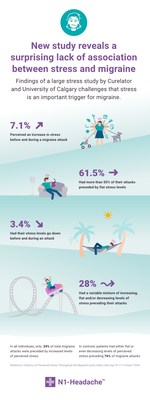New Study by the University of Calgary and Curelator Reveals Surprising Lack of Association Between Stress and Migraine
|
CAMBRIDGE, Mass., Jan. 22, 2021 /PRNewswire/ -- Curelator today announced new data that challenges the age-old belief that stress is a significant factor in triggering migraine attacks[1]. The results are published in the January issue of the leading Headache, The Journal of Head and Face Pain medicine journal, and they underscore the need for personalized phenotypic analysis and treatment plans in migraine. The study concludes that only 7.1% of patients had a majority of their attacks associated with increased levels of perceived stress. Most individuals, 61.5%, had more than 50% of their attacks preceded by flat stress levels. Only 3.4% of people had half of their attacks following decreasing levels of stress. The remaining portion of individuals, 28%, had a variable mixture of increasing, flat and/or decreasing levels of stress preceding their attacks. In addition, in all individuals, only 24% of migraine attacks were preceded by increased levels of perceived stress. In contrast, patients had either flat or even decreasing levels of perceived stress preceding 76% of migraine attacks. "These findings strongly suggest that, for the vast majority of patients, the role of perceived stress in triggering migraine attacks is less important than previously hypothesized," commented Serena Orr, M.D., senior author of the study, headache specialist, pediatric neurologist, and researcher at the Cumming School of Medicine, University of Calgary, Canada. "This contradicts the previous belief that increases in stress consistently trigger migraine attacks, because we found that this relationship is rather uncommon." The international study, conducted by Curelator and in collaboration with the University of Calgary, is the largest to date to examine the relationship between perceived stress and migraine: both in number of participants (n= 351 patients) as well as study duration (three months). During the course of the study, participants had a total of 2,115 migraine attacks, each of which were analyzed with respect to individual persons' daily stress levels before, during and after the attack. In comparison to traditional clinical studies, this one specifically examined individual patterns, not just aggregate patterns, in relation to how perceived stress changes in relation to the onset of pain of migraine attacks. Results showed a surprisingly high amount of variability between individuals and even within the same person. "Clearly, average population results can only be applied to a minority of individuals; providing compelling rationale for generating individual phenotypic profiles before administration of individual treatment plans," explained Marina Vives-Mestres, Ph.D., lead author, Analytics Lead at Curelator and Visiting Professor of Statistics at the Universitat de Girona (Spain). "The N of 1 methodology used in this study applies the approach of personalized medicine to help individuals understand their headache patterns," said Richard Lipton, MD, Edwin S. Lowe Professor and Vice Chair of Neurology and Director Montefiore Headache Center at Albert Einstein College of Medicine. "There is tremendous variation from person to person in their trigger factors. The typical approach of assessing population averages generates results that are difficult for individuals to apply. If red wine triggers your headaches but not mine, there is no need for me to avoid it.." Individualized digital data capture and analytics were enabled by Curelator's N1-Headache™, a digital platform that combines a simple smartphone data entry process with personalized N=1 analytics. After 90 days of data entry, the application generates Individual Trigger Map®, Protector Map® and No Association Map for each user incorporated within a Personal Analytical Report. The information featured in the Personal Report enables patients and their clinicians to generate individual, high resolution phenotypic profiles to manage risk factors, assess therapeutic response to drugs and monitor potential medication overuse. Reference 1 Marina Vives-Mestres, PhD ; Amparo Casanova, MD, PhD; Dawn C. Buse, PhD; Stephen Donoghue, PhD; Timothy T. Houle, PhD; Richard B. Lipton, MD; Alec Mian, PhD; Kenneth J. Shulman, DO; Serena L. Orr, MD, MSc. Pattern of Perceived Stress Throughout the Migraine Cycle: A longitudinal Cohort Study Using Daily Prospective Diary Data. Headache 2020; 0:1-16. About Curelator Founded in Cambridge, Massachusetts, in 2013, Curelator is a data-driven digital health company focused on developing clinical grade, personalised disease management tools for patients and clinicians. Since its inception, Curelator has published dozens of papers and abstracts in major headache and migraine journals and conferences, and it has enrolled thousands of patients on clinical studies through its N1-Headache™ platform. About N1-Headache™ N1-Headache™ is a unique patient engagement platform that delivers personalized, disease management tools for people with a history of migraine or medication overuse, allowing them to understand their migraine attack patterns in an individualized manner. This personalized information enables patients and their healthcare providers to manage individual migraine risk factors, assess therapeutic response to drugs and identify opportunities to prevent medication overuse. Contacts for additional information: Communications Agency
SOURCE Curelator |


